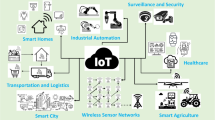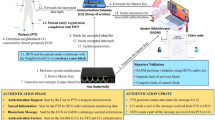Abstract
Identity-based user authentication protocols have been presented to be applicable to resource-constrained devices such as mobile phones. Unfortunately, the previous protocols have the drawback of the key escrow problem. A new protocol of a user authenticated key exchange for the mobile client-server environment is presented based on certificateless public key cryptography (CL-PKC). Our protocol solves the key escrow problem in user authentication schemes based on identity-based public key cryptography (ID-PKC). In addition, the proposed protocol is resisted to both adversaries’ types I and II and achieves perfect forward secrecy. The security of the proposed protocol has been proved using computational Diffie-Hellman (CDH) assumption in the random oracle model. Experimental results show that our scheme is better than He et al. and Tsai et al. schemes respectively in communication cost.






Similar content being viewed by others
References
Al-Riyami SS, Paterson KG (2003) Certificateless public key cryptography. In: International Conference on the Theory and Application of Cryptology and Information Security, Springer, pp 452–473
Bellare M, Rogaway P (1993) Random oracles are practical: A paradigm for designing efficient protocols. In: Proceedings of the 1st ACM conference on Computer and communications security, ACM, pp 62–73
Boneh D, Franklin M (2001) Identity-based encryption from the weil pairing. In: Annual International Cryptology Conference, Springer, pp 213–229
Boneh D, Lynn B, Shacham H (2004) Short signatures from the weil pairing. J Cryptol 17(4):297–319
Canetti R, Krawczyk H (2001) Analysis of key-exchange protocols and their use for building secure channels. Springer, New York, pp 453–474
Choon JC, Cheon JH (2003) An identity-based signature from gap diffie-hellman groups. In: International Workshop on Public Key Cryptography, Springer, pp 18–30
Daemen J, Rijmen V (2013) The design of Rijndael: AES-the advanced encryption standard. Springer Science & Business Media, Berlin
Das ML, Saxena A, Gulati VP, Phatak DB (2006) A novel remote user authentication scheme using bilinear pairings. Comput Secur 25(3):184–189
De Caro A, Iovino V (2011) jpbc: Java pairing based cryptography. In: Proceedings of the 16th IEEE Symposium on Computers and Communications, ISCC 2011, Kerkyra, Corfu, Greece, June 28–July 1, pp 850–855
Fang G, Huang G (2006) Improvement of recently proposed remote client authentication protocols. http://eprint.iacr.org/2006/200
Hamida EB, Javed MA, Znaidi W (2017) Adaptive security provisioning for vehicular safety applications. Int J Space-Based Situat Comput 7(1):16–31
Hassan A, Eltayieb N, Elhabob R, Li F (2016) A provably secure certificateless user authentication protocol for mobile client-server environment. In: International Conference on Emerging Internetworking. Data & Web Technologies, Springer, pp 592–602
He D (2012) An efficient remote user authentication and key agreement protocol for mobile client-server environment from pairings. Ad Hoc Netw 10(6):1009–1016
He D, Huang B, Chen J (2013) New certificateless short signature scheme. IET Inform Secur 7(2):113–117
Hou Mb, Xu Ql (2009) Secure certificateless-based authenticated key agreement protocol in the client-server setting. In: IT in Medicine & Education, 2009. ITIME’09. IEEE International Symposium on IEEE, vol 1, pp 960–965
Jaballah WB, Mosbah M, Youssef H, Zemmari A (2015) Lightweight secure group communications for resource constrained devices. Int J Space-Based Situat Comput 5(4):187–200
Jakobsson M, Pointcheval D (2001) Mutual authentication for low-power mobile devices. In: International Conference on Financial Cryptography, Springer, pp 178–195
LaMacchia B, Lauter K, Mityagin A (2007) Stronger security of authenticated key exchange. Springer, Berlin, pp 1–16
Nam J, Lee J, Kim S, Won D (2005) Ddh-based group key agreement in a mobile environment. J Syst Softw 78(1):73–83
Pointcheval D, Stern J (1996) Security proofs for signature schemes. In: International Conference on the Theory and Applications of Cryptographic Techniques, Springer, pp 387–398
Pointcheval D, Stern J (2000) Security arguments for digital signatures and blind signatures. J Cryptol 13(3):361–396
Ren Y, Wang H, Du J, Ma L (2016) Code-based authentication with designated verifier. Int J Grid Util Comput 7(1):61–67
Sabzevar AP, Sousa JP (2011) Authentication, authorisation and auditing for ubiquitous computing: a survey and vision. Int J Space-Based Situat Comput 1(1):59–67
Shamir A (1984) Identity-based cryptosystems and signature schemes. In: Workshop on the Theory and Application of Cryptographic Techniques, Springer, pp 47–53
Shen H, Gao C, He D, Wu L (2015) New biometrics-based authentication scheme for multi-server environment in critical systems. Journal of Ambient Intelligence and Humanized Computing
Shen J, Chang S, Shen J, Liu Q, Sun X (2018) A lightweight multi-layer authentication protocol for wireless body area networks. Future Gener Comput Syst 78:956–963
Shim KA, Lee YR, Park CM (2013) Eibas: An efficient identity-based broadcast authentication scheme in wireless sensor networks. Ad Hoc Netw 11(1):182–189
Sun X, Jiang Z, Zhou M, Wang Y (2014) Versatile identity-based signatures for authentication in multi-user settings. Int J Grid Util Comput 5(3):156–164
Tsai JL, Lo NW (2015) Provably secure and efficient anonymous id-based authentication protocol for mobile devices using bilinear pairings. Wirel Pers Commun 83(2):1273–1286
Tseng YM (2006) Gprs/umts-aided authentication protocol for wireless lans. IEE Proc Commun 153(6):810–817
Tseng YM (2007) A secure authenticated group key agreement protocol for resource-limited mobile devices. Comput J 50(1):41–52
Tseng YM, Wu TY, Wu JD (2008) A pairing-based user authentication scheme for wireless clients with smart cards. Informatica 19(2):285–302
Wang XA, Weng J, Yang X, Yang Y (2011) Cryptanalysis of an identity based broadcast encryption scheme without random oracles. Inform Proc Lett 111(10):461–464
Wang XA, Ma J, Yang X (2015) A new proxy re-encryption scheme for protecting critical information systems. J Ambient Intell Human Comput 6(6):699–711. https://doi.org/10.1007/s12652-015-0261-3
Wang XA, Ma J, Xhafa F, Zhang M, Luo X (2017) Cost-effective secure e-health cloud system using identity based cryptographic techniques. Future Gener Comput Syst 67:242–254
Wang Y, Ma J, Lu X, Lu D, Zhang L (2016) Efficiency optimisation signature scheme for time-critical multicast data origin authentication. Int J Grid Util Comput 7(1):1–11
Wong DS, Chan AH (2001) Efficient and mutually authenticated key exchange for low power computing devices. In: International Conference on the Theory and Application of Cryptology and Information Security, Springer, pp 272–289
Wu F, Xu L, Kumari S, Li X (2017) A privacy-preserving and provable user authentication scheme for wireless sensor networks based on internet of things security. Journal of Ambient Intelligence and Humanized Computing
Wu L, Zhang Y, Xie Y, Alelaiw A, Shen J (2016) An efficient and secure identity-based authentication and key agreement protocol with user anonymity for mobile devices. Wireless Personal Communications pp 1–17
Wu TY, Tseng YM (2010) An efficient user authentication and key exchange protocol for mobile client-server environment. Comput Netw 54(9):1520–1530
Yoon E, Yoo K (2010) A new efficient id-based user authentication and key exchange protocol for mobile client-server environment. In: Wireless Information Technology and Systems (ICWITS), 2010 IEEE International Conference on IEEE, pp 1–4
Zhang Y, Chen J, Li H, Cao J, Lai C (2014) Group-based authentication and key agreement for machine-type communication. Int J Grid Util Comput 5(2):87–95
Acknowledgements
This work is supported by the National Natural Science Foundation of China (Grant No 61272525), the Fundamental Research Funds for the Central Universities (Grant No. ZYGX2016J081) and the Laboratory for Internet of Things and Mobile Internet Technology of Jiangsu Province (Grant No JSWLW-2017-006).
Author information
Authors and Affiliations
Corresponding author
Rights and permissions
About this article
Cite this article
Hassan, A., Eltayieb, N., Elhabob, R. et al. An efficient certificateless user authentication and key exchange protocol for client-server environment. J Ambient Intell Human Comput 9, 1713–1727 (2018). https://doi.org/10.1007/s12652-017-0622-1
Received:
Accepted:
Published:
Issue Date:
DOI: https://doi.org/10.1007/s12652-017-0622-1




